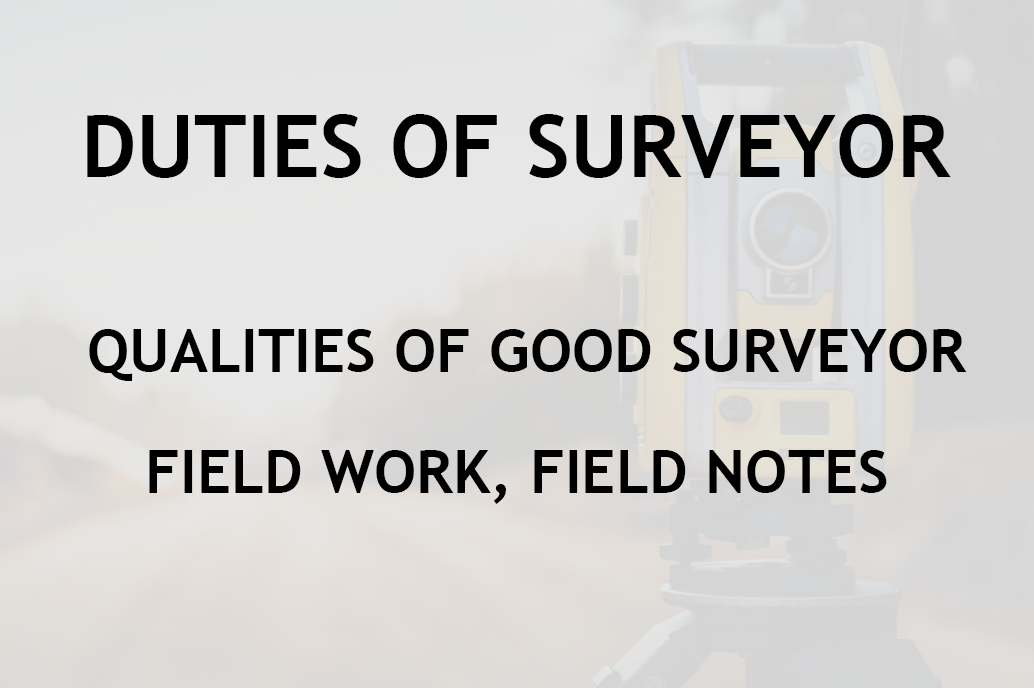DUTIES OF A SURVEYOR (SURVEYING) StudyCivilEngg.com
DUTIES OF A SURVEYOR
SUBJECT : SURVEYING
QUALITIES OF A GOOD SURVEYOR
- He should plan his work systematically.
- He should work carefully and accurately.
- He should record the observations in a neat and orderly fashion.
- He should know the relative importance of various measurements and should develop some sense of proportion as to what is important and what is not.
- He should have the essential habit of checking measurements and calculations.
The work of a surveyor can be divided into three distinct parts:
- Field Work
- Office Work
- Care and Adjustments of Instruments
FIELD WORK
- The field work consists of taking measurements and recording them in a proper field book. Some of the important operations are listed below.
- The first operation consists of reconnaissance to have the general idea of the topography of the area.
- The second operation consists of establishing control stations and bench marks as points of reference. Thus a system of horizontal controls and vertical controls is established.
- Depending upon the type of survey, the distances and angles are measured to establish main control network.
- The features such as boundary lines of the fields, roads, buildings, streams and bridges, are located by taking suitable measurements. These features in surveying are called details.
- If required, the elevations of various points are also determined. In topographic surveying, measurements of horizontal distances and elevations are taken for drawing contours to show reliefs (undulations).
- To make observations on the sun or stars to determine the meridian, latitude, longitude or the local time.
- In location surveys, to set out lines and points on the ground before construction for various engineering works, such as buildings, culverts, bridges, dams, sewers, water mains.
- In addition to above basic field operations, the surveyor may have to carry out miscellaneous operations such as establishing parallel lines and perpendiculars, taking measurements to inaccessible points.
FIELD NOTES
Field notes contain complete record of all measurements taken in the field. Field notes may be divided into four forms
- Numerical values and tabulation
- Sketches
- Explanatory notes and description
- Combination of all the above forms
Numerical Values and Tabulation - The record is kept in terms of numerical values in a tabular form. It includes the record of all linear and angular measurements, such as 152.60 m, 135°10’20". All significant figures should be recorded. For example, if a length is recorded to the nearest 0.01 m, it should be recorded as 152.60 and not 152.6 m.
Sketches - Sketches are drawn to show the outlines, relative locations, topographic features and other details. Liberal use of sketches should be made to explain the details which are likely to be misinterpreted. Whenever in doubt, it is always safe to illustrate with a sketch. Sometimes, a good sketch is worth a hundred words of description. Sketches need not be to scale. If measurements are put directly on the sketches, these should be clearly marked.
Explanatory Notes and Description - Explanatory notes and descriptions are given to make clear what is not absolutely evident from the numerical values and sketches. Sometimes, descriptions is given to record information concerning some important features of the ground and the work done which might be useful at a later date.
Combination of the above Three Forms - A good surveyor makes use of all the above three forms in a judicious manner to have a complete, self-evident record of the field work done. The competency of the surveyor is reflected in the field record. The field notes should be clear, legible, complete, concise and in a proper format. The following points should be borne in mind while recording field notes.
- Record the observation as soon as it is made. Do not depend upon the memory.
- Write the field notes directly in the bound field book, and not on a scrap of paper.
- As the field notes are permanent original record of the work done in the field, use a sharp hard pencil (3H or 4H) so that an impression is left on the paper. Alternatively, use a black ballpoint pen. Do not use a soft pencil or ink pen.
- The measurements are useless if these are not recorded properly or if some ambiguity exists in their interpretation. Necessary tables, sketches, diagrams and remarks should be included to clarify the recorded measurements.
- Incorrect entries should be cancelled by drawing a line and the correct values added above the scored entries. Erasures and overwriting are not permitted.
- The notes should be written in a simple, consistent style. Generally, the Reinhardt system of lettering is used for clarity, speed and simplicity.
- Use only standard abbreviations, signs and symbols. If there is any doubt about the meaning of a symbol, describe it fully.
- When working in areas where there is high humidity, apply a spray of thin coat of acrylic plastic on the pages of the field book to make the notes water proof.
- Start a new day’s work on a fresh page. Avoid crowding of the entries.
- Always record the title of the survey, date, the weather conditions, the names of surveyors, and the list of equipment on the field book.
FAQs COVERED IN THIS POST
WHAT ARE THE DUTIES OF A SURVEYOR?
WHAT ARE THE QUALITIES OF A GOOD SURVEYOR?
HOW IS THE WORK OF A SURVEYOR DIVIDED INTO?
WHAT IS FIELD WORK IN SURVEYING?
WHAT IS FIELD NOTES IN SURVEYING?
WHAT ARE THE PARTS OF FIELD NOTES?





Post a Comment